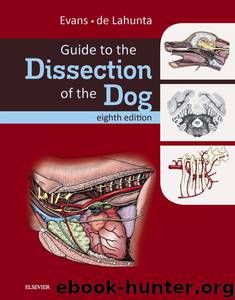Guide to the Dissection of the Dog - E-Book (.Net Developers) by Howard E. Evans & Alexander de Lahunta

Author:Howard E. Evans & Alexander de Lahunta [Evans, Howard E.]
Language: eng
Format: azw3
ISBN: 9780323392983
Publisher: Elsevier Health Sciences
Published: 2016-01-14T16:00:00+00:00
Fig. 4-20A, MRI of cranial abdomen.
1. Spleen
2. Fundus of stomach
3. Body of stomach
4. Pyloric antrum
5. Transverse colon
6. Jejunum
7. Ascending colon
8. Caudate lobe—liver
9. Right kidney
10. Descending duodenum
B, Lateral radiograph of the abdomen with barium.
1. Fundus of stomach
2. Body of stomach
3. Pylorus of stomach
4. Cranial duodenum
5. Caudal duodenal flexure
6. Duodenojejunal flexure
7. Jejunum
Source: (Part B from Evans HE, de Lahunta A: Miller’s anatomy of the dog, ed 4, St Louis, 2013, Saunders.)
The stomach is bent so that its greater curvature faces mainly to the left and its lesser curvature faces mainly to the right; its parietal surface faces cranioventrally toward the liver, and its visceral surface caudodorsally faces the intestinal mass. Its position changes depending on its fullness.
The empty stomach is completely hidden from palpation and observation by the liver and diaphragm cranioventrally and the intestinal mass caudally. It lies to the left of the median plane. The empty stomach is cranial to the costal arch and sharply curved, so that it is more V-shaped than C-shaped. The greater curvature faces ventrally, caudally, and to the left. This curvature lies above and to the left of the mass of the small intestine. The lesser curvature is strongly curved around the papillary process of the liver and faces craniodorsally and to the right. The left lobe of the pancreas and transverse colon are dorsocaudal to it.
The full stomach lies in contact with the ventral abdominal wall and protrudes beyond the costal arches. It displaces the intestinal mass. Open the stomach along its parietal surface, remove the contents, and observe the longitudinal folds of mucosa—the rugae.
The duodenum (see Figs. 4-9 through 4-11, 4-13, 4-14, 4-19, 4-20, 4-26) is the most fixed part of the small intestine. It is suspended by the mesoduodenum, which will be studied later. Reflect the greater omentum cranially and the jejunum to either side to expose the duodenum. The duodenum begins at the pylorus to the right of the median plane. After a short dorsocranial course, it turns as the cranial duodenal flexure. It continues caudally on the right as the descending part, where it is in contact with the parietal peritoneum. Farther caudally the duodenum turns, forming the caudal duodenal flexure, and continues cranially as the ascending part. The ascending part is short and lies to the left of the root of the mesentery, where it terminates at the duodenojejunal flexure (Fig. 4-20, B).
The jejunum forms the coils of the small intestine (Figs. 4-9 through 4-11), which occupy the ventrocaudal part of the abdominal cavity. They receive their nutrition from the cranial mesenteric artery, which is in the root of the mesentery. The root of the mesentery attaches the jejunum and ileum to the dorsal body wall. The mesenteric lymph nodes lie along the vessels in the mesentery. The jejunum begins at the left of the root of the mesentery and is the longest portion of the small intestine. Trace it from the duodenojejunal flexure on the left to its termination at the ileum on the right side of the abdomen.
Download
This site does not store any files on its server. We only index and link to content provided by other sites. Please contact the content providers to delete copyright contents if any and email us, we'll remove relevant links or contents immediately.
The Ultimate Pet Health Guide by Gary Richter(1726)
All Things Bright and Beautiful by James Herriot(1708)
Vet in Harness by James Herriot(1663)
Predation ID Manual by Kurt Alt(1655)
Chimpanzee Politics: Power and Sex among Apes by Frans de de Waal(1480)
Young James Herriot by John Lewis-Stempel(1477)
Veterinary Echocardiography by Boon June A(1378)
Creatures of the Rock by Andrew Peacock(1323)
All Things Wise and Wonderful by James Herriot(1323)
Vet in a Spin by James Herriot(1308)
Zoo Tails by Oliver Graham Jones(1278)
Exotic Animal Hematology and Cytology by Campbell Terry W(1276)
Black's Veterinary Dictionary by Edward Boden(1266)
David Sedaris Diaries by David Sedaris(1239)
Dr. Pitcairn's Complete Guide to Natural Health for Dogs and Cats by Richard H. Pitcairn & Susan Hubble Pitcairn(1166)
Calisthenics: Core CRUSH: 38 Bodyweight Exercises | The #1 Six Pack Bodyweight Training Guide by Pure Calisthenics(1138)
A Handful of Happiness by Massimo Vacchetta & Antonella Tomaselli & Jamie Richards(1123)
Biology and Diseases of the Ferret by Fox James G.; Marini Robert P.; & Robert P. Marini(1096)
Practical Physiotherapy for Veterinary Nurses by Carver Donna;(1035)
